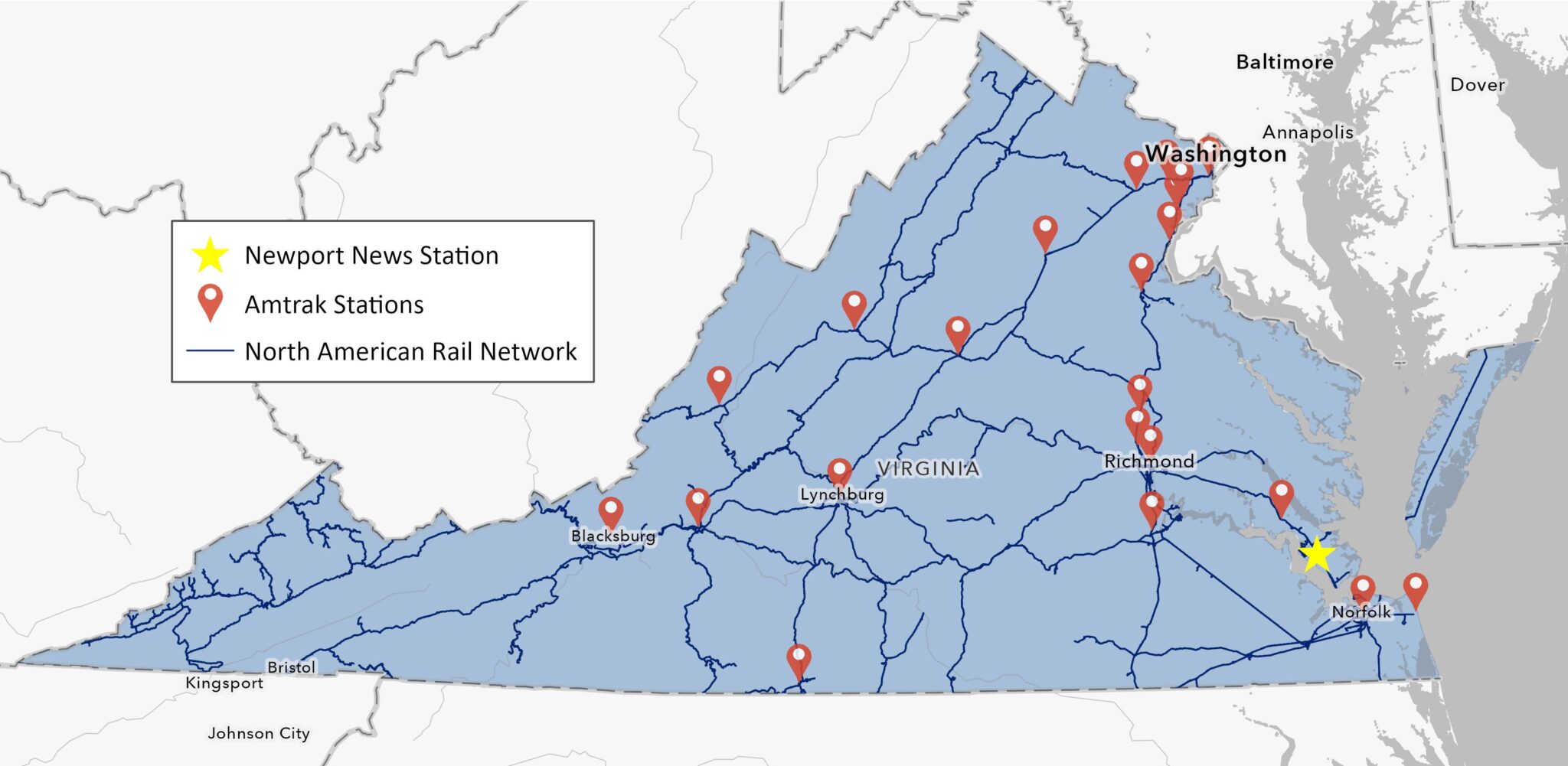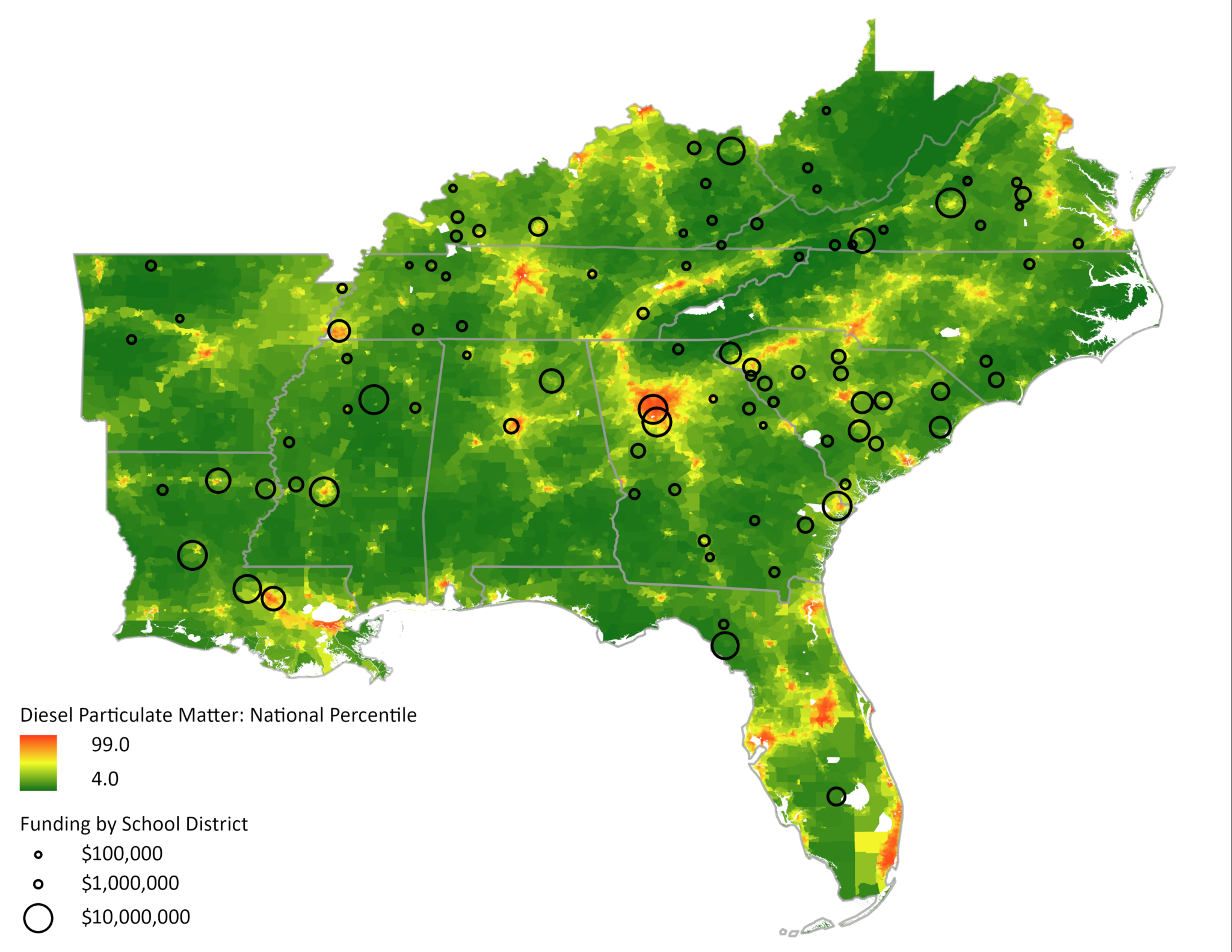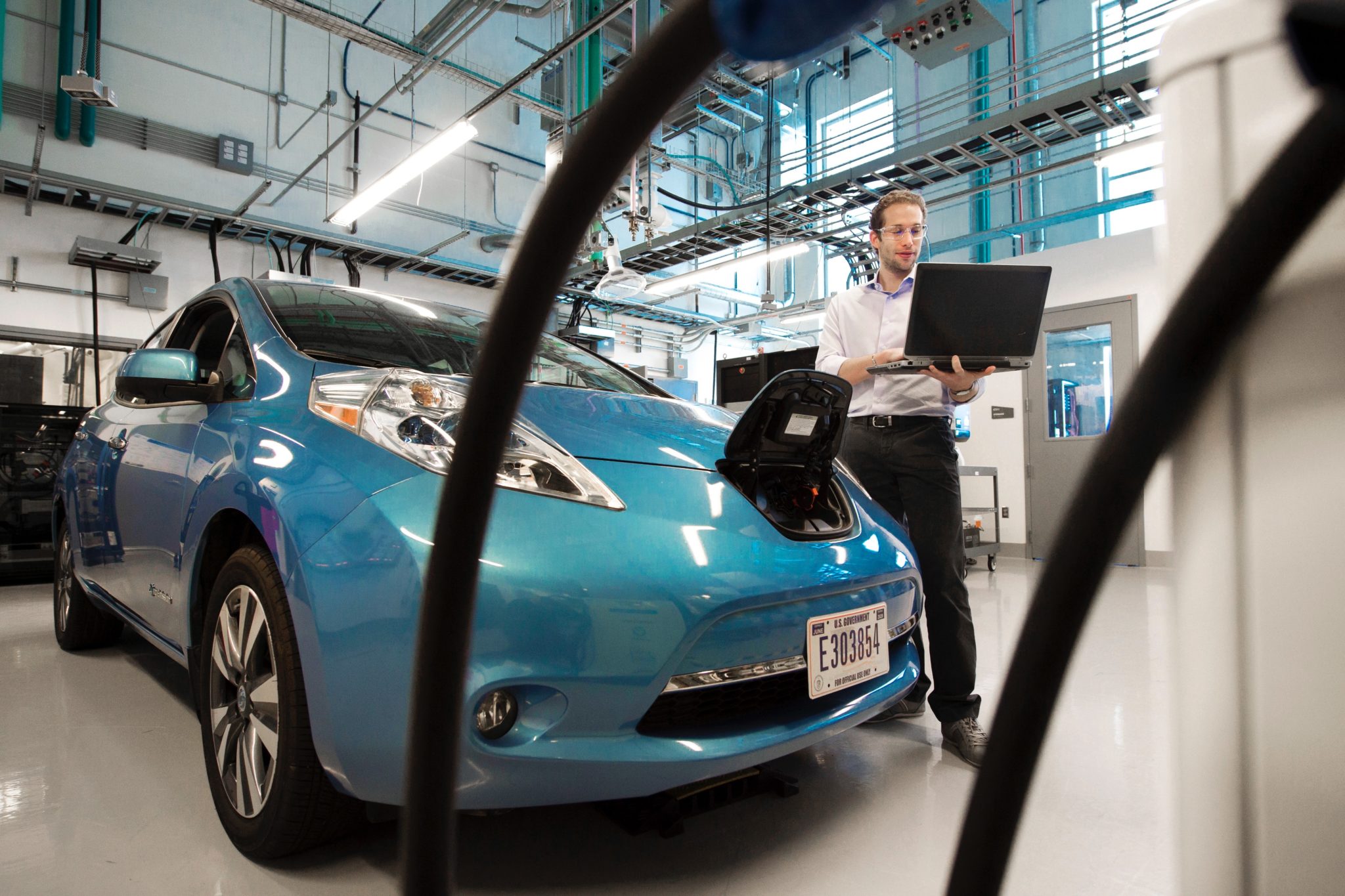Category: Transportation
Virginia is for Rail Lovers: A Record Year for Rail Travel
By Elizabeth Willis, SEEA Buildings Research Associate
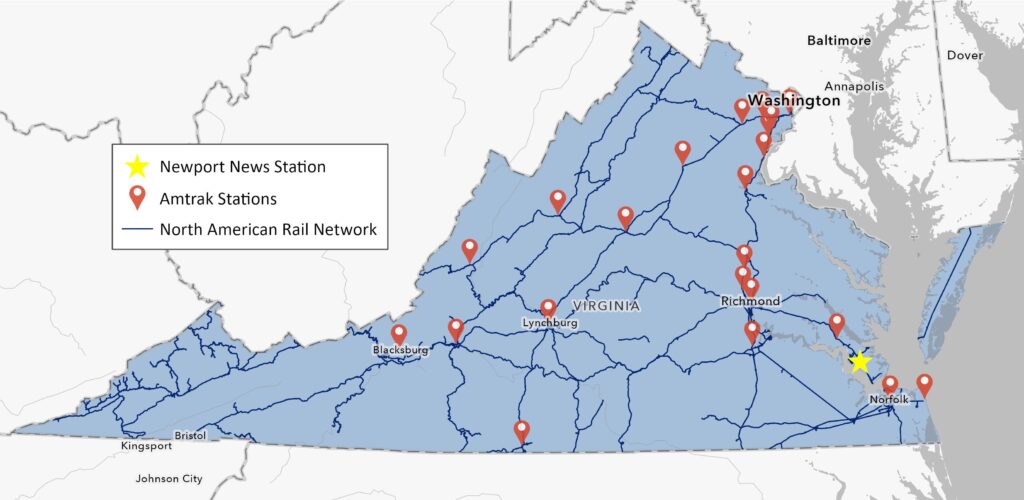
Map: Southeast Energy Efficiency Alliance. Source: U.S. Department of Transportation.
From the mountains to the coast, Virginia’s railways are riding a wave of renewed energy and expanding ridership. 2024 was an exceptional year for passenger rail in Virginia. With a record-breaking 1.39 million riders on Amtrak Virginia service, the Commonwealth is proving that convenient, comfortable, and sustainable transportation is not only possible, but thriving. This milestone marks a 4.8% increase over 2023 and an impressive 45% jump from pre-pandemic ridership levels in 2019. It’s safe to say: Virginia is for rail lovers.
Since launching state-supported service in 2009 with just one roundtrip between Washington, D.C. and Lynchburg, Virginia’s rail network has increased into eight daily roundtrips serving 17 stations across four key corridors: Roanoke, Norfolk, Newport News, and Richmond. Riders can enjoy seamless, one-seat rides, without having to transfer trains from Virginia to major East Coast destinations like New York, Boston, and Philadelphia thanks to the integration with Amtrak’s Northeast Corridor.
But the growth isn’t just about numbers, it’s about the people choosing trains over traffic. “Our 2024 record ridership represents more than just holiday travel,” said DJ Stadtler, Executive Director of the Virginia Passenger Rail Authority (VPRA), “It is indicative of Virginians using passenger rail as a convenient part of their travel plans.” Taking the train is often more affordable, less stressful, and much easier than driving hundreds of miles. A trip from D.C. to Norfolk, for instance, saves travelers nearly 400 miles behind the wheel.
This commitment to rail is backed by meaningful infrastructure investments. One of the most exciting developments this year was the opening of the Newport News Transportation Center in August 2024. This modern multimodal hub connects passengers to Amtrak, local buses, airport shuttles, and taxis, serving as a gateway to both regional and long-distance destinations. Features like ADA-compliant platforms, real-time train information, a spacious waiting area, and Amtrak ticketing staff onsite will enhance the rider’s experience and make train travel more accessible for everyone.
The Newport News project is a shining example of what can be accomplished when public agencies and communities work together. Amtrak, VPRA, CSX, FRA, DRPT, VDOT, and the City of Newport News collaborated to bring this state-of-the-art station to life. As Mayor Phillip Jones put it, “This is a landmark achievement for our city and a testament to the power of collaboration.” Additionally, Christiansburg is getting an Amtrak extension, as Governor Glenn Youngkin recently broke ground on the New River Valley Project.
Beyond the numbers, what makes this success story so exciting is what it represents: a shift in how Virginians move. As the state continues to grow and evolve, passenger rail is helping close transportation gaps, especially in areas without direct interstate access, and giving travelers a smart, reliable alternative to car travel.
With strong ridership, expanded service, and a growing network of modern transportation hubs, Virginia is proving that the future of travel is not only on track, it’s right on time.
This work was made possible through our collaboration with TEEM Virginia. TEEM, which stands for Towards Equitable Electric Mobility, is a national Community of Practice, a peer-to-peer network of organizations advancing equitable mobility across the U.S. In Virginia, our cohort includes the NAACP, Generation180, Virginia Organizing, Ceres, and the Southeast Energy Efficiency Alliance, working together to create more just and inclusive transportation solutions.
National Emissions Standards: Unleashing Health & Economic Potential for the Southeast
By: Justin Brightharp
On March 20th and March 28th, the United States Environmental Protection Agency (U.S. EPA) finalized national emissions standards for passenger cars, medium-duty trucks and vans, and heavy-duty vehicles, respectively, applying to vehicle model years 2027 through 2032. These standards are expected to establish the United States as a leader in the clean transportation space, improve air quality, and lower fuel and operating costs for consumers.
Light-duty and Medium-duty Standard Projected Benefits
- CO2 reduced by 7.2 billion metric tons
- $13 billion in annual health benefits
- Particulate Matter reduced 8,700 tons by 2055
- NOx reduced 36,000 tons by 2055
- Volatile Organic Compounds reduced by 150,000 tons by 2055
- $46 billion in reduced annual fuel costs by 2055
- Almost $16 billion in reduced annual maintenance and repair costs
Heavy-duty Standard Projected Benefits
- 1 billion metric tons of greenhouse gas emissions avoided from 2027 to 2055
- Reduce air pollution for 72 million people near freight routes
- $13 billion in annualized benefits through 2055:
- $10 billion in climate benefits
- $300 million in benefits from PM reduction
- $3.5 billion in annual savings
Both standards are performance-based emissions, allowing flexibility in building gasoline vehicles with better engines and transmissions and increasing access to energy-efficient vehicle options like hybrid electric vehicles, plug-in hybrid electric vehicles, battery-electric vehicles, and hydrogen fuel cell vehicles. The southeast is home to billions of dollars in private investments from manufacturers along the electric vehicle supply chain, expecting tens of thousands of jobs. The transition towards transportation electrification will benefit the entire United States and local communities across the Southeast.
Projected Electric Vehicle Manufacturing Investments by State 2023

Map: SEEA. Data Source: Atlas Public Policy EV Hub Automaker Dashboard
Projected Electric Vehicle-Specific Jobs by State in the Southeast

Map: SEEA. Data Source: Atlas Public Policy EV Hub Automaker Dashboard
Supporting electric vehicle production requires manufacturing batteries, building vehicle chassis and bodies, building and deploying charging stations, vehicle and charging station maintenance, and battery recycling, all of which can be found in the southeast region. The U.S. EPA projects that 67% of new light-duty vehicle sales and 46% of new medium-duty vehicles could be electric due to the new emissions standards. Thousands, if not millions, of electric vehicles sold in the United States and globally could be built in the southeast region with rippling effects.
For every 100 direct jobs in a durable manufacturing industry, like automotive, over 744 indirect jobs are created. Through 2025, the Southeast region’s existing and announced private investments are expected to bring $93 billion and almost 170,000 direct manufacturing jobs for electric vehicles. This could mean over 1.2 million additional jobs from suppliers and induced jobs from existing and future businesses, including small businesses.
Projected Indirect Jobs from Electric Vehicle Manufacturing in the Southeast 2023

Map: SEEA. Data Source: Economic Policy Institute Employment Multiplier Report. Jan. 2019
The national emission standards for light-duty and medium-duty vehicles, as well as heavy-duty vehicles, provide consumers with health benefits and cost savings and emphasize consumer choice. One of the pathways to improved air quality and health, as well as affordable electric vehicles, for the United States, runs through many communities in the Southeast. The Southeast is poised to see economic growth and the many health and cost benefits from both emissions standards through the thousands of manufacturing jobs created by the electric vehicle supply chain and over a million indirect jobs. Coupled with federal tax incentives: $7,500 for new light-duty electric vehicles, $4,000 for used electric vehicles, and $40,000 for new commercial medium- and heavy-duty electric vehicles built in the United States and the billions of dollars of public investment from the Bipartisan Infrastructure Law and Inflation Reduction Act, we can further accelerate towards cleaner air and better health in our communities.
Growth of electric vehicle infrastructure offers hope for repair and renewal
Shrika Madivanan, Digital Communications Intern and Justin Brightharp, Senior Program Manager
Updated January 4, 2024
Pursuing equitable solutions starts with acknowledging the legacies of discrimination in in southeastern energy and transportation systems. In 2023, SEEA created three new StoryMaps that take a look at how energy security and equity impact transportation in Florida, Georgia, and South Carolina. We used data from federal and state sources alongside stakeholder feedback that tell a story about how transportation systems impact Black and brown communities and low- to moderate-income communities.
Each StoryMap utilizes unique data and stakeholder engagement, but share a common narrative that recognizes the unequal distribution of the benefits of clean transportation, community inclusion in decision-making, and burdens of emissions. They also provide policy recommendations that support an equitable transition to zero emission transportation. The StoryMaps are a resource for decision-makers and other stakeholders to identify which communities have experienced the most negative impacts from the transportation system and how to pursue federal and state funding opportunities that reduce transportation emissions, economically support communities and improve local public health.

SEEA is committed to acknowledging the influence of historic racism within the energy sector and related industries such as healthcare, insurance, housing finance and transportation. Racial segregation has always been a part of our country’s transportation systems and these historical inequalities still impact energy efficiency and transportation equity today. SEEA is developing a set of maps that illustrates how transportation infrastructure places additional burdens on people of color, and how zero emission public transit, fleets, and personal vehicles can address these issues.
One of the most notable challenges in the system is an absence of charging systems in Black, Latino, low income and rural communities. The lack of accessible charging stations in minority communities today is the result of a long history of prioritizing white spaces. When Congress approved the Federal-Aid Highway Act of 1956, they intended to ensure “speedy, safe transcontinental travel,” but in doing so they also displaced many Black households. Many Black neighborhoods were demolished to build the interstate highway system, which amplified existing inequities like racial segregation and poverty. The destruction of these vibrant communities made accessing basic needs such as housing and access to clean air a burden for those who lived there.

Black residents who were not displaced experienced ongoing discrimination because the newly built highways cut off minority neighborhoods from economic opportunity. Often excluded from white neighborhoods, they were pushed to find new housing in communities already segregated by race and class. This put Black communities at an even greater disadvantage when looking for quality housing, employment opportunities and public services.
Public transit also has a history of racial inequality. When streetcars were first introduced, they initially created opportunities for people of color, making travel throughout cities more convenient. Still, segregation remained commonplace through mechanisms like separation screens and assigned seats. Though these explicit tools used to perpetuate racism have since been outlawed, access to public transit is still stratified by race.
Many public transit systems today are built on the foundation of two different consumers, “choice” and “dependent” riders. These terms mask descriptions of white and Black people, concealing biases toward white riders. This bias appears in transit system design. Systems are built under the assumption that “choice riders” need accommodations such as new rail lines and more accessible routes because they have a choice, whereas “dependent riders” receive the bare minimum as they have no room to be selective. Transit systems take extra steps to build schedules, route structure and infrastructure centered around white people. This bias extends to electric vehicles (EVs). The EV sector is growing quickly, aided by consumer interest and an influx of federal funding. This time of growth and transition provides an opportunity to build a better system and not repeat the mistakes of the past.
While improvement is still needed, public transit has reduced emissions and provides affordable, necessary services. The use of zero-emission buses is one example of the transit system making strides to be more sustainable and accessible. The Southeast has the second largest percentage of zero-emission buses in the nation, just behind the western states. The transit agencies that serve Lexington, KY, Chattanooga, TN, and Orlando, FL are regional leaders in low and zero emission buses. Last month, the City of Orlando released its 2030 Electric Mobility Roadmap outlining the city’s vision for cleaner, more equitable mobility opportunities from public transit to EV adoption to multimodal options.
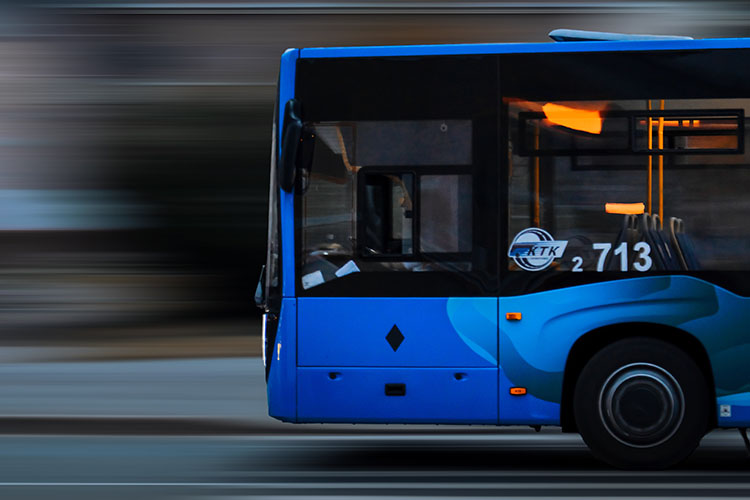
Accessible, clean transportation creates opportunity and improves the quality of life for all. In addition to increasing the number of locations of charging systems, increasing the different types of charging systems ensures charging is easy to access and affordable. State and federal incentives like rebates reduce the upfront cost to purchase a new or used EVs, removing an additional barrier to adoption.
There are multiple obstacles that impact widespread EV adoption in minority and low income communities. Charging infrastructure is not widely available yet and it’s estimated that 80% of EV charging occurs at home and work. If a driver’s home or place of work does not have charging stations, they will need to install a charger at home, which increases upfront costs. Most Americans buy used vehicles as opposed to new vehicles. However, used electric vehicles are harder to find at most used car dealerships. Although the majority of people in the U.S. and Southeast drive personal vehicles, many people rely on other forms of transportation such as motorcycles, bikes, and public transit. Improving fleet electrification – the transition of light-duty vehicles, trucks, and delivery trucks to electric vehicles – is essential to expanding accessibility and provides additional options for clean transportation.
Transitioning to more low and zero emission vehicles is critical to Black, Latino and low income communities adjacent to interstate highways and travel corridors. Black and Latino communities are disproportionately affected by air pollution, and the lack of electric vehicles and charging stations within these communities contributes to emissions levels. From 1990-2019, a hike in demand for travel resulted in an increase in CO2, methane, and N2O emissions from buses by 162% and from medium and heavy-duty trucks by 92.9%. Medium and heavy-duty vehicles, including buses, account for less than 10% of vehicles on the road but contribute more than 60% of NOx and PM emissions.
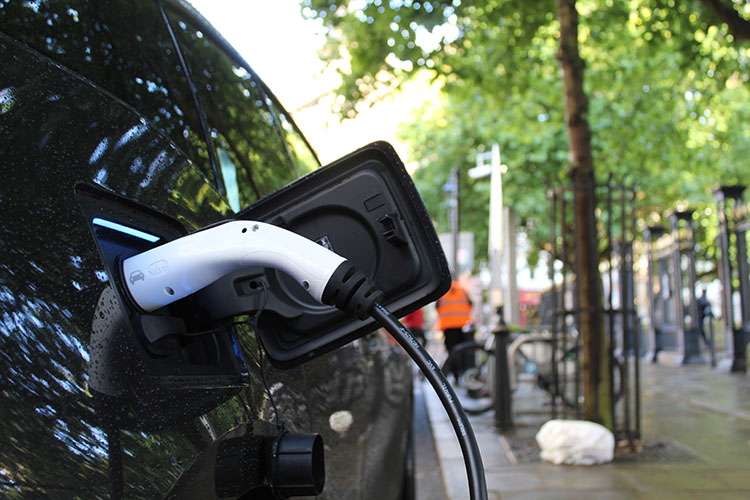
Prioritizing building charging infrastructure in Black, Latino, low income and rural communities will make EV adoption easier, more affordable, and inclusive of all people living in the Southeast. Improving the accessibility of charging infrastructure will give way to new economic growth locally and regionally. EV drivers have longer dwell times, up to 45 minutes, at charging stations compared to gas stations. This extended break encourages time at nearby businesses like restaurants or shopping. In the Southeast, the EV manufacturing sector is expected to add thousands of jobs and billions in revenue to states and municipalities.
SEEA uses resources like StoryMaps to engage with regional and national decision makers on how to make the transition to low-and-zero carbon emissions vehicles more affordable and accessible and move towards a more just transportation system. We plan on publishing a new StoryMap focused on transportation and equity soon. If you have questions about this work, contact Senior Manager, Justin Brightharp.
Map of the Month – September
Grace Parker
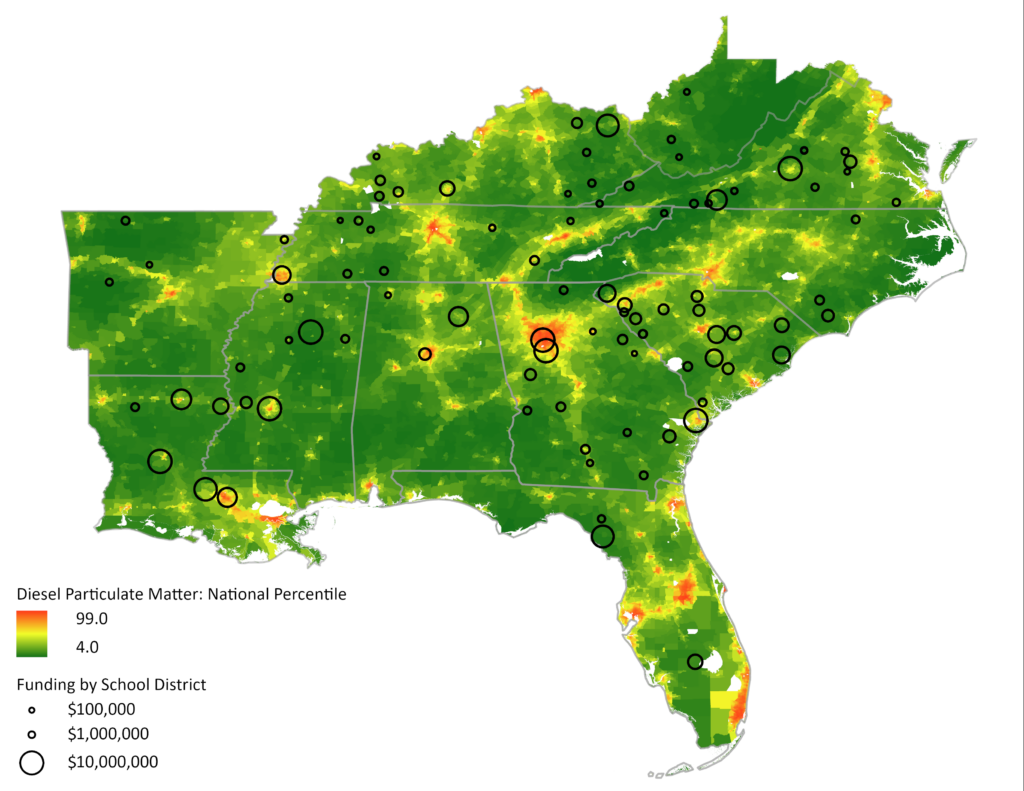
Map: Southeast Energy Efficiency Alliance
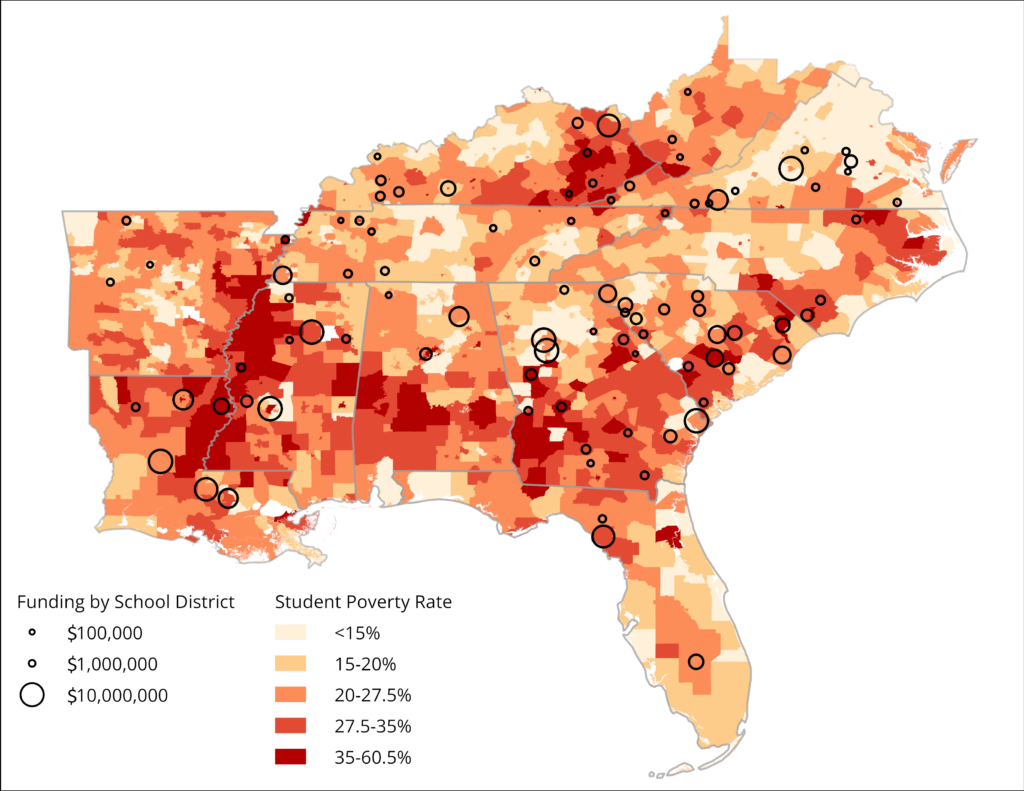
Map: Southeast Energy Efficiency Alliance
The EPA’s Clean School Bus Program aims to reduce greenhouse gas emissions and exposure to air pollution by replacing older school buses with low-emission and zero-emission models. Has that funding reached the communities most impacted by the harmful effects of diesel school buses? Diesel buses produce diesel particulate, which has been linked to an increased risk of asthma and cancer. A part of the Bipartisan Infrastructure Law, the Clean School Bus Program provides funding to school districts to purchase new low-emission and zero-emission buses. This funding supports a global reduction of greenhouse gas emissions, local air quality improvements, and health benefits to nearby communities.
This month’s maps show that the school districts that were awarded program funding in 2023 are generally more rural, have high student poverty rates and lower levels of diesel particulate, especially compared to more urban districts. The EPA prioritizes funding for rural school districts, high-need local education agencies, and schools that serve residents of Native American lands. High-need local education agencies include districts where 20 percent or more of students served are from low-income families. The student poverty map shows that most of the funding went to these districts. The Clean School Bus Program largely supports schools that have smaller budgets and serve students from lower-income communities.
This month’s maps reveal a tension between funding districts that have the most difficulty paying for clean school buses and funding districts with the highest diesel particulate pollution. However, we can target funding to areas that need support to overcome both of these challenges, like New Orleans. Although a district with similar needs in Birmingham received a $3.6 million grant, New Orleans districts did not. School districts seeking cleaner air and better health for their communities need additional outreach and technical assistance to support their funding applications to the Clean School Bus Program. By focusing on districts that face multiple obstacles to their achieving their goals, we can deepen the impact of this historic and critical funding.
How to navigate growing pains in the rapidly evolving electric vehicle value chain
Rekha Menon-Varma, Vertaeon LLC and Justin Brightharp, Southeast Energy Efficiency Alliance (SEEA)
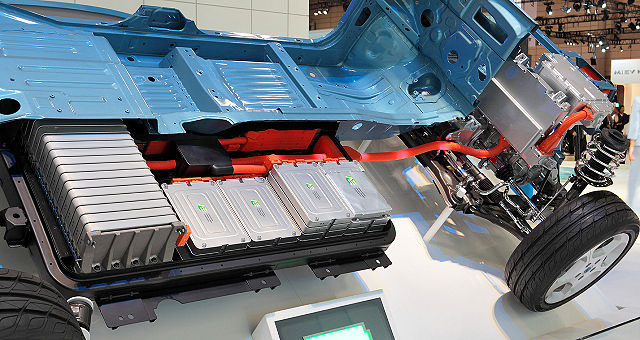
The COVID-19 pandemic has exposed far-reaching supply chain vulnerabilities on items ranging from food and medical supplies to semiconductor chips. The automotive industry, in particular, has weathered severe production impacts due to the chip shortage. On the growth side, billions of dollars of investment is expected along the electric vehicle (EV) supply chain from automotive manufacturers, battery manufacturers, battery recycling facilities, and other stakeholders, including major investments in the Southeastern United States (U.S.). These investments are expected to create thousands of jobs and generate billions in economic value.
The joint webinar led by Vertaeon LLC and SEEA on March 9, examines potential risks in the EV value chain. In this blog, we take a brief look at current and evolving risks. The key takeaway is that manual risk assessments will not be sufficient in this fast-paced, global, EV market evolution. ‘The automotive industry will need to continuously track and analyze risks as they emerge and leverage advanced analytics and artificial intelligence (AI) to do so to enable EV market growth.
As the EV supply chain continues to develop, grow, and mature, it’s crucial for all stakeholders, from manufacturers to the end user, to manage expectations as it relates to vehicle and battery performance, infrastructure access, maintenance, and technology advancements. To meet these aggressive adoption goals, many automotive manufacturers are vertically integrating battery production and vehicle assembly either within their networks or through partnerships. The Biden administration has made it a priority to foster the growth of the electric transportation supply chain to enhance national security and mitigate risks. Diverse stakeholders such as investor-owned utilities, municipal utilities, and electric cooperatives will need to coordinate during this process. Additionally, this creates opportunities to further develop the value chain through identifying risks, offering solutions to mitigate those risks, and bridging gaps among partners to achieve higher resiliency.
Emerging challenges – Vertaeon Perspectives
By December 2021, several countries and automotive market leaders have pledged a move towards electric vehicles to curb greenhouse gas emissions (GHG) and decarbonize the transportation sector. Automakers in the U.S., China, Japan, and European Union (E.U.) are reportedly targeting 40-60% of new vehicle sales to be EVs by 2030-2035. While this is excellent news, both on the technology front and for addressing climate change, aggressive growth in EVs will mean overhauling production, developing new skills, and building new partnerships. Even if those requirements are met, limited raw material availability and constraints in the battery supply chain can severely hamper growth plans.
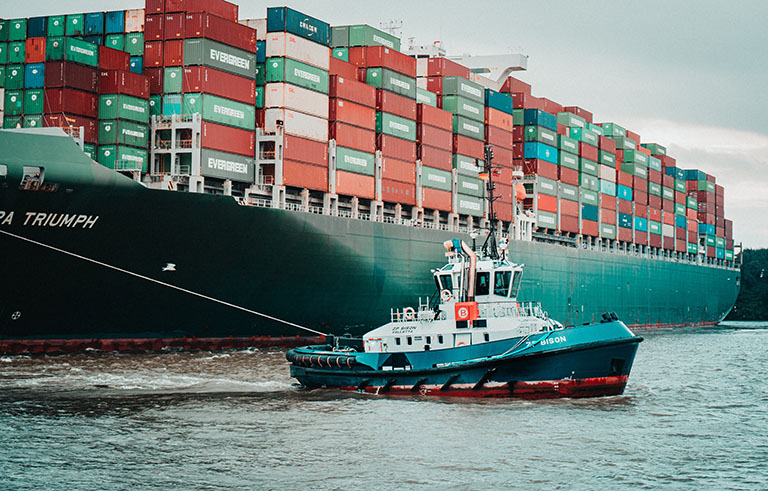
“One thing is clear – manual risk assessments will not be sufficient in this fast-paced, global, EV market evolution”
Vertaeon commented
There are six major risks to consider as the EV value chain evolves:
- Financial & Legal Risks: The revenue and profit impacts of 2021 present big challenges for the automotive industry, caused mainly by supply shortages, logistics, and the pandemic, while calling for major investments in the EV space. A company’s financial stress is a key risk indicator which provides insight for determining winners and potential for bankruptcies. Legal disputes such as the one between LG Chem and SK Innovation could impact battery and other key technology delivery. Legal events and disputes can severely curtail supply and impact local jobs.
- Player Concentration: The current EV value chain has fully integrated players with captive supply and large players have been integrating upward via partnerships with battery producers. The main battery producers are in Asia, in China, and South Korea. This points to the need for strategic planning by the U.S. and E.U., to establish their own supply and be resilient.
- Raw material and Battery-related risks: Lithium and cobalt prices surged in 2021, along with semiconductor price increases. Raw material sources are concentrated in Africa, South America, and Australia while most battery production is in China and South Korea. It is key to assess and track critical minerals sourcing locations and pricing in the supply chain.
- Geopolitical Risks: The U.S., E.U., and China account for 90% of the EV market and growth projections. China is estimated to make 73% of the world’s lithium-ion batteries. Ongoing U.S.-China discussions can potentially impact battery supply, intellectual property rights, and trade agendas, with outcomes in location strategies, and local partner developments.
- Environmental, Social, and Governance (ESG) risks: A slew of social and governance risks surround the EV supply chain including conflict minerals from the Democratic Republic of the Congo, the toxicity of cobalt, corruption indices of source countries, and labor issues to name a few. It is critical to map the supply chain and continuously monitor not only from a company’s sustainability perspective, but more importantly from a regulatory perspective.
- Innovation risks: Product and process innovation will dictate pricing/kWh, overall vehicle pricing and consumer adoption. Process innovation that utilizes alternate raw materials or critical components will eliminate some of the above risks. However, innovation can take years to come to fruition and require large investments, with a steep learning curve.
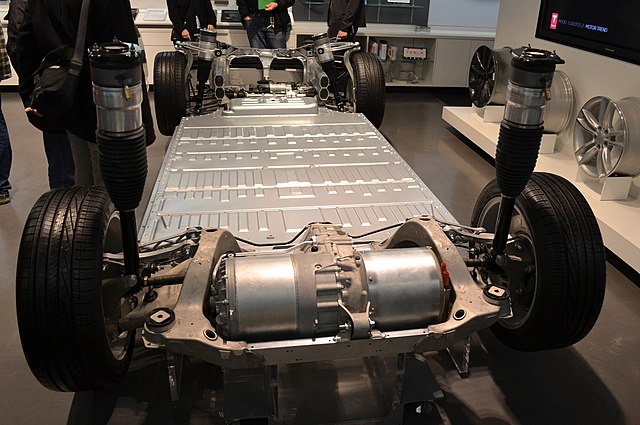
These risks are also opportunities for applying advanced analytics/AI and utilizing insights for risk mitigation and competitive advantage. It has become imperative to assess and track risks and volatility continuously, and to leverage technology and subject matter expertise.
Federal Funding Opportunities for EV Supply Chain – SEEA Notes
The Biden administration has prioritized investment in electric transportation projects and the electric vehicle supply chain. Federal funding programs are an opportunity for stakeholders interested in transitioning their fleet to apply for funds. In November 2021, the Infrastructure Investment and Jobs Act was signed into law and includes provisions for investments into the supply chain. Atlas Public Policy’s EV Hub provides a breakdown of the legislation. The implementation and timeline for distributing funds is still being developed. Additionally, you can watch the recording of SEEA webinar, Advancing Electric Transportation: How to Leverage Federal Support in the Southeast, which provides a federal overview of investments into electric transportation. SEEA encourages stakeholders to stay informed as funding opportunities announcements are released by respective federal agencies.
Join us on March 9, 10 a.m. ET for the companion webinar on EV value chain risks with Vertaeon and SEEA!
Authors: Rekha Menon-Varma is managing partner at Vertaeon LLC, an advanced data analytics firm focusing on Enterprise and Supply Chain Risk and ESG analytics (SaaS tools) and insights. Vertaeon offers scalable and customizable SaaS web platforms, with easy implementation and actionable insights for decision-making. Justin Brightharp is SEEA’s energy efficient transportation manager. He supports SEEA’s transportation initiatives through policy, research, and stakeholder engagement.
For media inquiries to Vertaeon contact Brandon McKay Crooks
For media inquiries to SEEA contact Sarah Burgher
Disclaimer: The content in this article is intended for informational purposes only. Vertaeon provides no endorsement and makes no representations as to accuracy, completeness, or validity of any information or content on, distributed through or downloaded, or accessed for this article. All rights and credit go to original content owners from various sources. No copyright infringement is intended. Vertaeon will not be liable for any errors, omissions, or delays in this information or any losses, injuries, or damages arising from its display or use. All information is provided on an as-is basis without any obligation to make improvements or to correct errors or omissions. Vertaeon makes no guarantees or promises regarding the sources and does not necessarily endorse or approve of their content. You may contact Vertaeon at www.vertaeon.com with any questions.
Our top blog posts of 2021

In 2021, the covid-19 pandemic continued to influence our desire to improve the safety and efficiency of our indoor spaces and we saw an increased public and private investment in energy-efficient technology, manufacturing, and policy. SEEA welcomed a new president, and we expanded and deepened our commitment to equity within our industry. In this notable year, these are the blog posts that you read, shared, and liked the most.
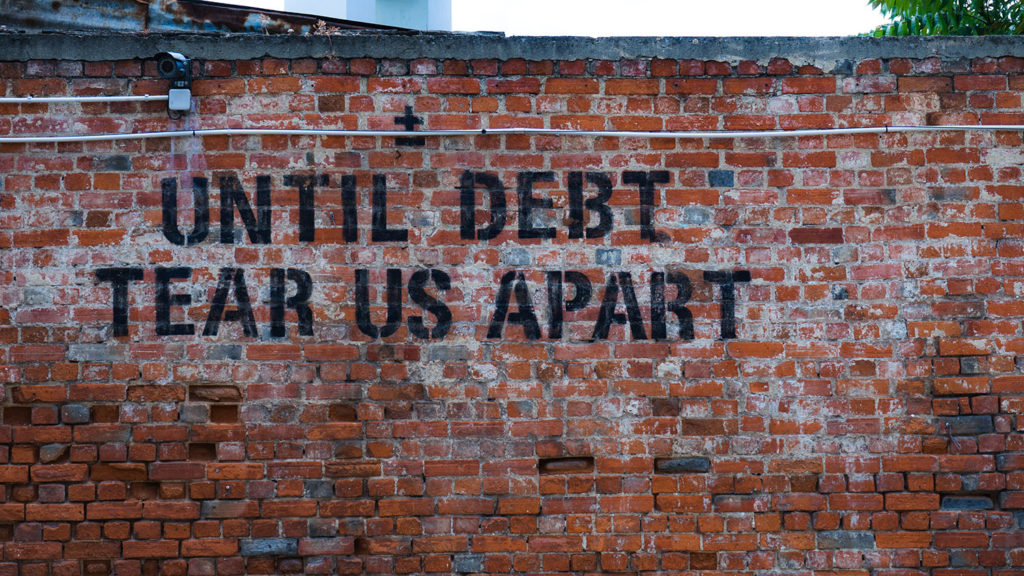
1. What is energy security versus energy burden?
Originally published March 15, 2021
Last month, SEEA released our report, Energy Insecurity Fundamentals for the South. We believe using common metrics is essential to creating robust and prescriptive policies that address the multiple dimensions of energy insecurity. […]

2. Going beyond recovery with the American Jobs Plan
Originally published April 22, 2021
For patients recovering from a major illness or trauma, doctors stress the importance of improving social wellness as a part of recovery. They prescribe getting back on your feet as the first step, but note that staying healthy requires a long-term investment in one’s physical, mental, and social health. […]

3. Energy efficiency for all – the opportunity ahead
Originally published May 6, 2021
While I officially started working at SEEA on April 26, I have had the pleasure of working with SEEA staff and board members for more than ten years. The team’s dedication to realizing a more energy efficient Southeast that benefits all people has long inspired my curiosity […]

4. How American Efficient is realizing a more diverse energy industry
Originally published November 10, 2021
The American Efficient DEI Action Team
Over the last year, a team at American Efficient developed a Diversity, Equity, and Inclusion (DEI) action plan to put some of our company’s values into practice. As a group of mostly white people in a mostly white company—and industry—we regard this as a privilege, in all senses of the word. […]
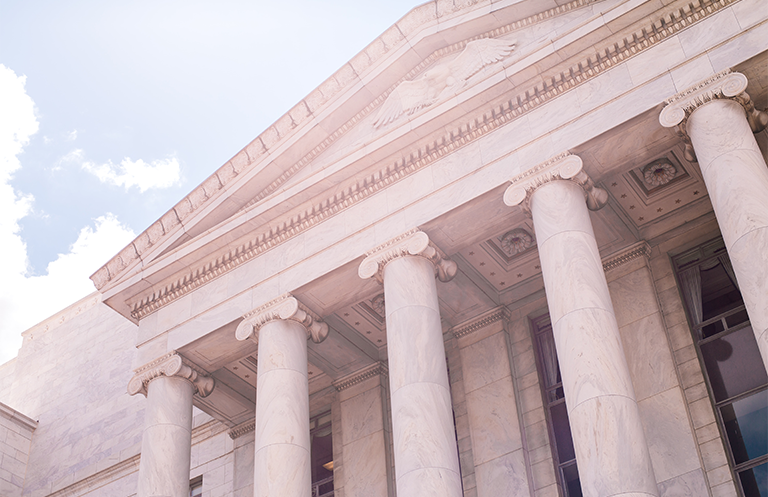
4. The Infrastructure Investment and Jobs Act will transform the Southeast
Originally published November 12, 2021
On Friday, November 5, the U.S. House of Representatives passed the Infrastructure Investment and Jobs Act. The bill passed the Senate in a bipartisan vote in August and President Biden is expected to sign the bill on Monday, November 15. The $1.2 trillion package is a historic investment in infrastructure that advances energy efficiency, resiliency, and electric transportation. Combined with the President’s Build Back Framework, it will average 1.5 million additional jobs every year for the next 10 years. […]
All the places we’ll go – clean cars, trucks, buses, and jobs!
Anne Blair
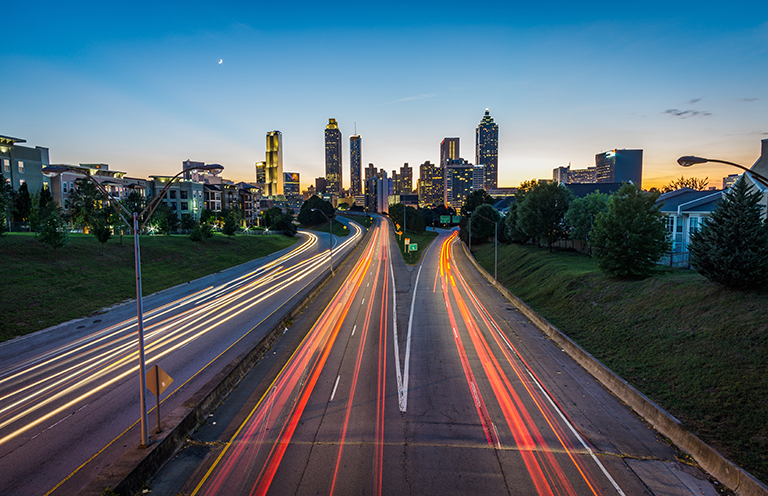
America loves to drive. There are nearly 280 million vehicles on the road and the average person drives around 13,500 miles a year. The demand for transportation accounts for $1.9 trillion, or 9.1% of the GDP. We spend more money on transportation than we do on education ($1.4 trillion [6.5%]) and nearly as much as we do on food ($2 trillion [9.4%]). Our car-loving culture and transit-driven economy comes at a price beyond what we spend on vehicles and the gas that powers them. Our current system’s focus on personal, internal-combustion engine vehicles for every American was fueled by the creation of the interstate highway system in the 1950s and ‘60s. That sweeping infrastructure investment came at the expense of downtown, majority Black communities, and reliable mass transit systems in most American cities. Currently, just 3% of the trips Americans take are by mass transit.
Transportation is also the largest source of greenhouse gas emissions in the United States. Those emissions contribute to a warmer climate, higher rates of heat-related and respiratory illness, more severe weather, and sea level rise among other things. These factors increase the cost of healthcare, insurance, and housing. In the Southeast, the impacts of climate change are more disproportionately felt in low-income and Black communities. These neighborhoods are often bordered by transit corridors and lag in green infrastructure compared to wealthier or white counterparts.
Even accounting for emissions created by generating electricity, plug-in electric vehicles (EVs) are still three times cleaner than comparable gasoline-powered vehicles. However, there are only 1.8 million EVs currently registered in the U.S., representing less than 2% of all vehicles on the road. The U.S. market share of EVs is a fraction of the Chinese market and China has eight times as many charging points for EVs than America. With strategic investment, the U.S. has an opportunity to lead in EV manufacturing, infrastructure, drive down the price of EVs, increase demand, and create jobs.
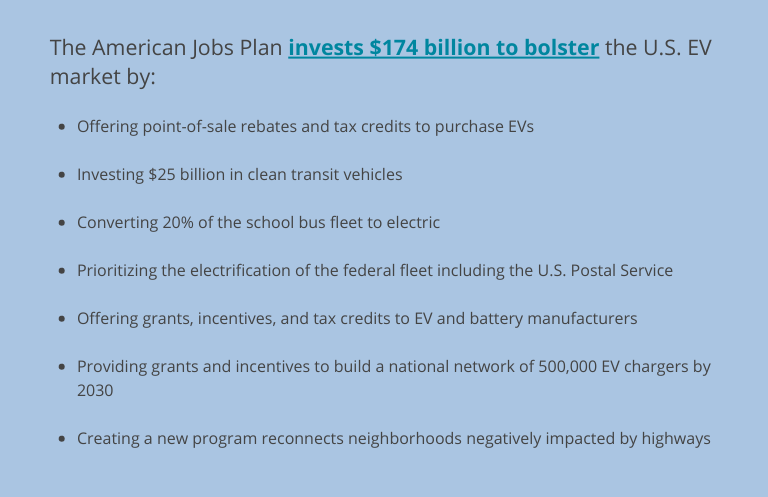
The American Jobs Plan proposes expanding availability and access to energy efficient transportation by investing in a strong domestic supply chain for EVs and parts, growing the market for EVs, building a national network of charging infrastructure, creating an equitable and modern public transit system, and reconnecting communities that were purposefully divided by highway projects.
In the Southeast, EVs are revitalizing existing manufacturing infrastructure by adapting operations, or inviting new business. Blue Bird is making electric school buses in Fort Valley, GA; SK Innovation is building two battery facilities and just announced a joint venture with Ford Motor; Mercedes-Benz announced its Tuscaloosa County plant will start producing electric SUVs in 2022; Schnellecke Logistics Alabama is adding a new warehouse and jobs to support Mercedes-Benz; in Spring Hill, TN, GM is transitioning its existing plant to build electric vehicles and recently announced Ultium Cells LLC, a joint battery cell venture with LG Energy Solution; battery maker Microvast is building a new factory in Clarksville, TN; Sese Industrial Services is adding a new plant to their operations in Chattanooga, TN to make axle components for the Volkswagen EV line; and in the Carolinas, Arrival is building a headquarters and two microfactories to produce electric delivery vans.
The increase in EV production, in response to growing sales, requires charging infrastructure to match consumer demand. In addition to the upfront cost, range anxiety remains one of the top reasons people and businesses are hesitant about switching to EVs. Federal efforts, like the Department of Transportation’s intention to build charging infrastructure throughout the National Highway System provide a solid start to the transition away from fossil fuels towards a more efficient, and cleaner transportation future.
The American Jobs Plan breaks with precedent not only by not encouraging any expansion of the existing road network, but alternately proposing more modern and affordable public transit and rail, road safety measures for pedestrians, and reconnecting neighborhoods historically harmed by highway projects. A more reliable and resilient energy infrastructure that supports electrification also will decrease emissions in communities disproportionately impacted by transportation pollution while also reducing our sensitivity to market volatility, offers new opportunities in utility services, and provides storage capacity for renewable energy that can keep people safe in the face of disaster.
The powerful combination of consumer demand alongside federal policy focused on electric transportation has the potential to transform our communities into healthy places to live and work, gives us more efficient ways to connect with one another and in more ways, and lays a foundation for healthier communities for all residents in the Southeast and nationally.
Energy efficiency for all – the opportunity ahead

While I officially started working at SEEA on April 26, I have had the pleasure of working with SEEA staff and board members for more than ten years. The team’s dedication to realizing a more energy efficient Southeast that benefits all people has long inspired my curiosity and pushed me to expand how I view energy efficiency solutions. The team has consistently worked to understand the utility landscape and bring together leaders, advocates, and businesses to address the region’s most complex energy problems.
I sometimes hear the argument that energy efficiency is no longer relevant, that all the proverbial sockets have been plugged. However, energy efficiency is an evolving set of solutions that can offset the impact of a warming climate and I believe we are far from maximizing its many benefits. In Atlanta, the median energy cost burden is 32% higher for Black households and 52% higher for Hispanic households compared to white households. Energy efficiency lifts people out of poverty and contributes to a thriving, equitable economy in the Southeast. It is our single greatest resource in addressing the effects of climate change and the disproportionate energy burden costs for low-income and non-white households.
Our region’s health and housing issues can be mitigated through energy efficiency. Energy insecurity affects 35% of all homes in the South, and 7.5 million households have received utility disconnection or stop service notices. Residents in energy insecure homes, particularly children, are at higher risk for chronic illnesses like asthma that can be made worse by pests, moisture, and thermal distress. Lack of access to healthy, affordable homes is rooted in racist housing segregation and voter disenfranchisement, which still shape the region’s energy and housing sectors. Weatherization programs, along with updated energy codes for new construction as well as existing buildings keeps housing affordable, safe, and healthy for all communities, regardless of income.
Energy efficient transportation is also a powerful resource in combating the harmful effects of vehicle pollution. It reduces the outsized impact of poor air quality on low-income communities and communities of color. To counteract the historic inequities in transportation infrastructure, everyone must be included in the decision-making process to find ways for the energy and transportation sectors to create more affordable and accessible mobility options. Through education, collaboration, and promoting a diverse array of perspectives we can create wide-reaching policy that benefits all people who live in the Southeast.
Energy has become a necessary requirement of our modern lives. The fear of being without energy services keeps many people up at night, whether it is families struggling to keep the heat on or braving the hot summer without air conditioning to cover food and medication costs. This fear was a reality of my childhood. It drives me to eliminate that worry for future generations and ensure that all residents in the Southeast live, work, and play in healthy, affordable, resilient buildings.
We are fortunate to be entering an unprecedented time to improve our infrastructure through strategic investments in energy efficient housing and transportation, expanding manufacturing, and creating a more diverse workforce. This investment marks a new era in American history, an opportunity to build systems that provide more wealth, better health, and stronger communities for all of us. Here in the Southeast, we have the greatest opportunity for growth and expansion in the country. I am personally inspired and eager to embark on this journey with the team at SEEA. Their passion, commitment to SEEA’s mission, and deep well of knowledge energizes me and gives me the determination to seek out new partners, better solutions, and a more prosperous South for all.
Our Top Energy Efficiency Stories of 2020
SEEA Staff

2020 was a year of firsts and hopefully some never-agains. We experienced the first global pandemic in over a century, grieved over the tragic consequences of systemic racism, and felt the uncertainty of a growing economic recession. The energy sector and the Southeast did not go unscathed. In this time of loss, we found resilience and a renewed purpose to bring our values into our work every day. These are the stories that kept us up at night, gave us hope, and reminded us that there is still work to be done.
Energy-Efficient Transportation
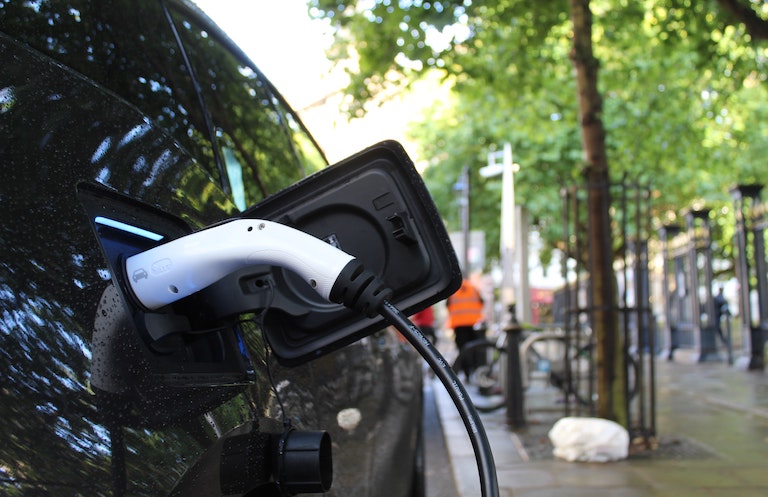
Electric vehicle (EV) infrastructure expanded throughout the Southeast in 2020. In North and South Carolina, Duke Energy Progress and Duke Energy Carolinas were approved to implement electric vehicle pilot programs that include the installation and operation of EV charging stations in public places and multifamily communities as well as publicly accessible fast-charging stations. The Florida legislature passed Senate Bill 7018, which paved the way for the development of a statewide electric vehicle infrastructure master plan. In December 2020, the Florida Department of Transportation submitted its draft of policy recommendations and is expected to complete the master plan by July 1, 2021.
EV manufacturing boomed throughout the region. Mercedes-Benz U.S. International has planned a new EV parts facility near Tuscaloosa, AL. GM announced plans to transition its existing assembly plant in Spring Hill, TN, to its third electric vehicle manufacturing plant in North America. Arrival, the U.K. electric vehicle startup, has chosen Charlotte, NC for its headquarters after announcing plans to build a microfactory in nearby Rock Hill, SC. These developments keep or create over 4,000 jobs in the Southeast and represent a $3 billion investment in local economies.
Energy Efficiency Policy

In spring 2020, the Virginia General Assembly passed and approved the Virginia Clean Economy Act (VCEA), requiring state utilities to produce 30% of their energy from renewables by 2030, close all carbon-emitting power plants by 2050, and attain mandatory energy efficiency savings targets. Additionally, the General Assembly made the Virginia Council on Environmental Justice a permanent advisory body to the executive branch, after operating on a temporary basis for nearly two years. The council will provide recommendations to protect vulnerable communities and integrate environmental justice into the state’s daily operations.
In 2019, four of the seven utilities subject to the Florida Energy Efficiency Conservation Act (FEECA) proposed reducing their energy efficiency goals to zero, or nearly zero, for the next decade. The Florida Public Service Commission (FPSC) rejected those goals and began to assess with state legislators how they might reform or reinterpret FEECA to improve energy savings. In early 2020, the FPSC opened docket 20200181 and requested commission staff to propose changes to the processes of setting goals and approving programs for energy efficiency. On January 14, 2021, policy director Cyrus Bhedwar participated in a workshop held by the FPSC on the FEECA revision process. The FPSC is accepting written public comments until February 15.
Both of these acts set the stage for decades of improved energy efficiency goals and clean energy standards, providing a healthier, more just future across the Southeast.
Built Environment

The onset of the economic recession caused by the COVID-19 pandemic revealed and made worse existing inequities in housing and energy for millions of Americans. In September 2020, research from Indiana University confirmed that energy insecurity, the inability to pay utility bills, is higher in households of color than their white counterparts. The American Council for an Energy Efficiency Economy (ACEEE) listed Birmingham, AL as the city with the highest energy burden and Alabama, Kentucky, Mississippi, and Tennessee the most energy burdened states in the country.
Because of this existing economic inequity, Black and Latino communities are most at risk for utility shut-offs. Access to electricity, gas, water, and broadband are all crucial to remaining healthy during a pandemic and sheltering at home.
2020 also affirmed that energy efficiency regulation works. An April FEMA study found that strong building codes, including energy codes, in Florida and California will save the country’s most disaster-prone states $1 billion annually. In its annual progress report, Department of Energy’s Better Buildings Initiative reported nearly $11 billion in savings since its inception a decade ago.
Diversity, Inclusion, & Integration

This summer there was a national calling to confront systemic racism and reform police practices. In the midst of this reckoning, private and public changes moved the region and the energy sector towards equity. In July 2020, Georgia Power’s Senior Vice President of Metro Atlanta & Corporate Relations Bentina Chisolm Terry took on an expanded role that includes Georgia Power’s work in underserved communities – people of color, the elderly, women, and LGBTQ+. In October 2020, Terry, and her colleague Latanza Adjei, Vice President of Corporate Services, were selected to the Atlanta Business League’s list of “Atlanta’s Top 100 Black Women of Influence.”
In August 2020, Department of Energy announced the first slate of Equity in Energy Ambassadors and Champions. The Ambassadors are responsible for leading efforts for ensuring diversity and equal access to energy. In Mississippi, residents overwhelmingly voted in the general election to remove Confederate imagery from the state flag. Similarly, Alabama voters approved an amendment that starts the process of deleting racist language from the state constitution inserted during the Jim Crow era.
While this work is not complete, these steps bend the arc of the universe just a bit more towards justice and equity.
EV batteries show the promise of cleaner, electrified transportation
Anne Blair
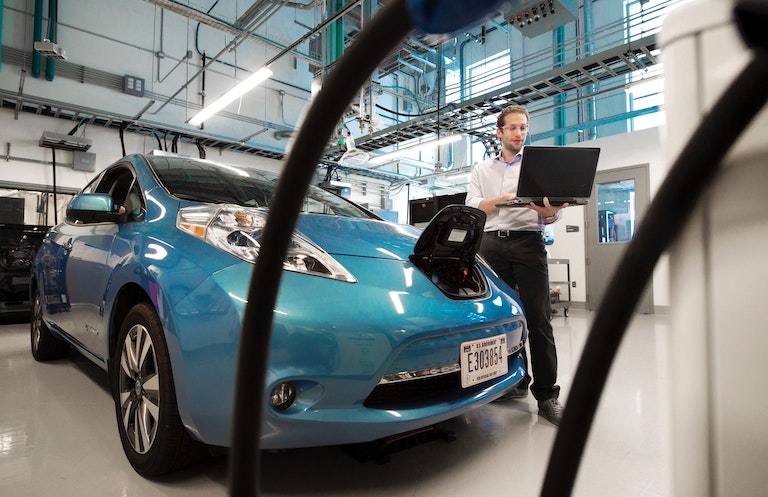
As we identify cleaner alternatives to gas and diesel-powered vehicles, electric vehicles (EVs) have become clear front-runners as the cleanest, most affordable option for personal and commercial use. Demand for EVs has steadily increased over the last decade as models have become cheaper and more powerful. The success of a select few, light-duty EVs, has morphed into a much bigger movement, which now includes electric buses and trucks, delivery vehicles, and more entering the market.
The battery plays a crucial role in the long-term success of electric vehicles. It is responsible for the vehicle’s range and power, yet it is also the most controversial and expensive part of an EV. Lowering the cost of a battery is key to lowering the overall costs of EVs and allows them to reach cost parity with gasoline-powered vehicles. Batteries, however, are not without their flaws. From material extraction, manufacturing, and disposal, these processes can all have negative environmental consequences. As the number of EVs grows, finding safe, affordable, and environmentally friendly ways to make these batteries and keep them out of landfills poses a challenge and opportunity.
Current research addresses weaknesses of lithium-ion batteries
Research is advancing quickly alongside the increase of EV adoption. Costs are expected to match those of gasoline vehicles by 2023.
Research teams across the world are seeking ways to reduce the impacts of EV batteries in each stage of its lifecycle. In the Southeast, Clemson University is researching ways to improve battery production, which would significantly lower costs and increase the power of EV batteries. Georgia Tech is working on a range of battery projects including developing strategies to remanufacture, repurpose, and recycle spent EV batteries. The study further evaluates the use of recycled batteries in smart homes and local electrical grids. In other areas of the country, IBM is using materials extracted from seawater to build a new battery that does not use heavy metals. Early testing shows that it can be optimized to surpass the capabilities of lithium-ion batteries including lower cost, faster charging time, higher power and energy density, strong energy efficiency, and low flammability. Tesla is developing an EV battery that is free of cobalt, one of the most expensive and difficult battery elements to mine.
Battery production provides economic growth opportunities
Battery production companies like SK Innovation are expanding and creating new economic opportunities in the region, with the development of two battery plants in Georgia. This growth brings potential to build infrastructure to reuse and recycle EV batteries and create jobs in the Southeast.
Second-life uses reduces the environmental impact of EV batteries
As EVs age and come off the road, the second life battery supply is projected to exceed 200 gigawatt-hours per year by 2030. This will not only exceed the demand for lithium-ion battery storage, it exceeds a value of $30 billion. The Southeast can look to places like China or Europe for standardization procedures for used batteries, recycling incentives for consumers, and other policies that can encourage battery reuse and recycling and support a growing EV economy.
With an increased number of new models of electric light, medium, and heavy-duty vehicles in development, experts predict that electric vehicle sales to be half of overall vehicle sales worldwide by 2040. However, this future is contingent on the components and prices of EV batteries as clean and inexpensive as possible. Our recent report, “EV Battery Benefits, Challenges, & Trends,” details the core concerns about battery technology and the current state of the battery industry, including:
- Why is lithium-ion the most popular type of EV battery?
- What are the alternatives to lithium-ion?
- How can EV batteries be used in their second life?
- What does EV battery recycling look like?
- What policies exist that support recycling and battery reuse?
Municipalities and state leaders, business leaders, fleet directors, and others are looking for opportunities to make their operations more sustainable, reduce their energy impacts, and protect the environment. Shifting fleets to cleaner, electric options, will play a key role in those plans. This report gives insight into the battery industry and the benefits and opportunities of electric transportation.
Questions? Contact energy efficient transportation manager, Justin Brightharp.


